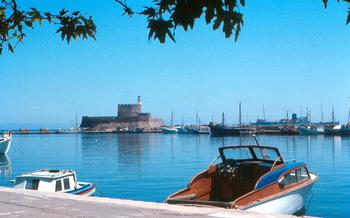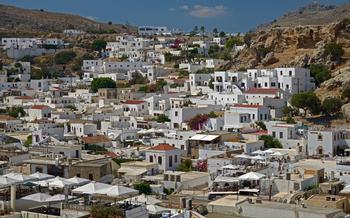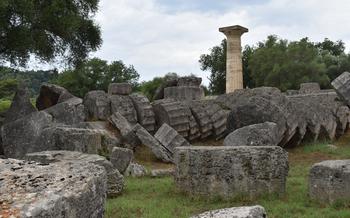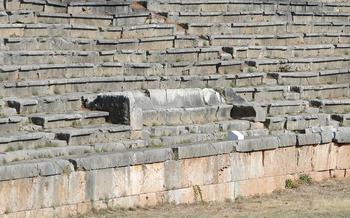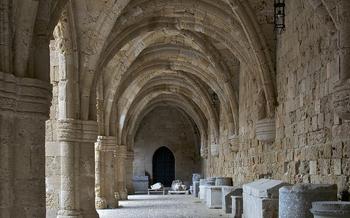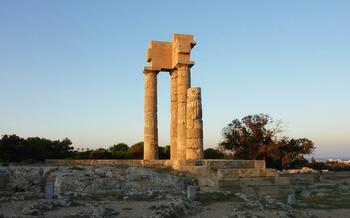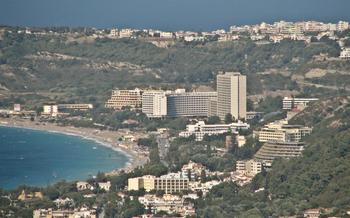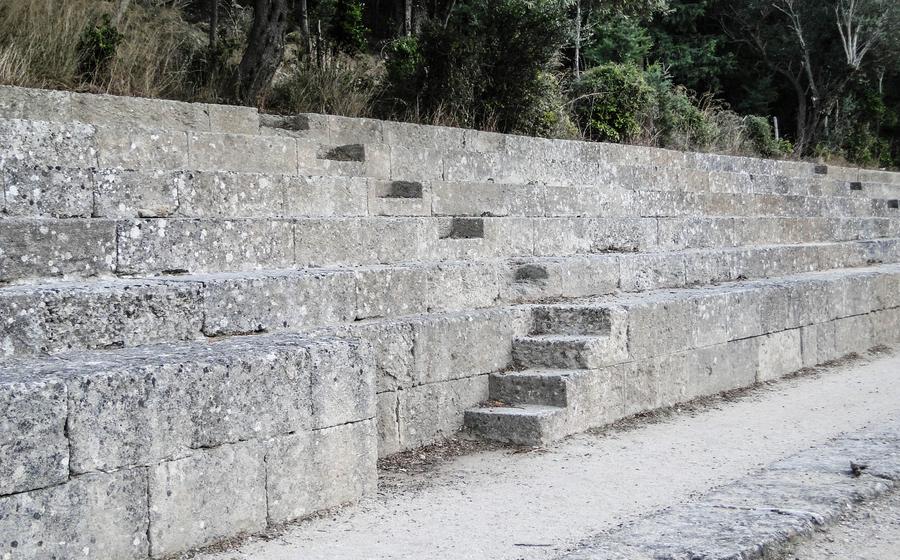
Ancient Stadium of Rhodes
- A Journey Through Time: Exploring the Ancient Stadium of Rhodes
- Unveiling the History of the Stadium
- A Masterpiece of Ancient Architecture
- Finding the Ancient Stadium: A Guide for Visitors
- Highlights for History Buffs and Architecture Enthusiasts
- Transport Yourself Back in Time with a Visit
- Experience the Ancient Olympic Games
- Witnessing Religious Ceremonies and Festivals
- A Glimpse into the Development of Rhodes
- Tips for Making the Most of Your Visit
- Capturing the Perfect Shot: Photography Tips
- A Haven for History and Architecture Lovers
- A Journey Through the Ages: A Historical Timeline
- Insider Tip: Uncovering Hidden Gems
A Journey Through Time: Exploring the Ancient Stadium of Rhodes
Journey back in time to the era of ancient Greece as you explore the awe-inspiring Ancient Stadium of Rhodes. This iconic landmark, nestled in the heart of the island, stands as a testament to Rhodes' rich history and architectural prowess. Built in the 3rd century BC, the stadium served as a prominent venue for sporting events, religious ceremonies, and festivals, playing a pivotal role in the cultural and social fabric of ancient Rhodes.
Historical significance: The Ancient Stadium of Rhodes is a significant reminder of the island's glorious past. Constructed during the Hellenistic period, it hosted various athletic competitions, including wrestling, boxing, running, and chariot races, mirroring the grandeur of the renowned Olympic Games.
Architectural features: Marvel at the stadium's remarkable architectural features, showcasing the ingenuity of ancient Greek builders. Its elongated U-shaped design, carved into the natural hillside, provided ample seating for spectators. The tiers of stone benches, meticulously arranged in concentric rows, accommodated thousands of enthusiastic onlookers.
Location and accessibility: Conveniently located within the city of Rhodes, the Ancient Stadium is easily accessible by foot or public transportation. Its proximity to other historical sites, such as the Acropolis of Rhodes and the Old Town, makes it an ideal starting point for exploring the island's rich heritage.
Must-see highlights: Don't miss the stadium's impressive starting line, where athletes poised themselves for victory. Admire the intricate stone carvings that adorn the seating areas, depicting scenes from mythology and daily life. Imagine the roar of the crowd as you stand at the center of the track, feeling the energy of the ancient games.
Unveiling the History of the Stadium
The ancient stadium of Rhodes played a pivotal role in the cultural and sporting landscape of the island. It served as a stage for various events that showcased the athleticism, artistry, and religious devotion of the ancient Rhodians.
Ancient Olympic Games: The stadium was a prominent venue for the ancient Olympic Games, which were held every four years in honor of Zeus, the king of the gods. These games featured a range of athletic competitions, including running, wrestling, boxing, and chariot races. The victors were crowned with olive wreaths and hailed as heroes upon their return home.
Sporting Events and Competitions: Beyond the Olympic Games, the stadium hosted numerous other sporting events and competitions throughout the year. Local athletes competed in various sports, demonstrating their strength, agility, and skills. These events fostered a sense of camaraderie and friendly rivalry among the Rhodians.
Religious Ceremonies and Festivals: The stadium was not merely a place for athletic contests; it also served as a sacred space for religious ceremonies and festivals. The Rhodians gathered here to honor their gods and goddesses, offering sacrifices, performing rituals, and participating in processions. These events showcased the deep religious beliefs and traditions of the ancient Rhodians.
Role in the Development of Rhodes: The ancient stadium was more than just a sports arena; it played a significant role in the development of Rhodes. It attracted visitors from across the Greek world, boosting the city's economy through tourism and trade. The stadium also served as a venue for political assemblies and public announcements, contributing to the civic life of Rhodes.
A Masterpiece of Ancient Architecture
The Ancient Stadium of Rhodes stands as a testament to the architectural prowess of the ancient Greeks. Its unique design and construction set it apart from other stadiums of its time. Built entirely of local limestone, the stadium features a distinctive U-shape with a central playing field surrounded by tiers of seating. The seating arrangements were carefully designed to provide spectators with an unobstructed view of the events taking place below.
The stadium's athletic facilities and amenities were equally impressive. It boasted a running track, a jumping pit, and a wrestling area. There were also provisions for training and warm-up spaces for the athletes. The stadium's design also incorporated water channels to ensure proper drainage and prevent flooding during heavy rains.
Preservation efforts have been instrumental in maintaining the integrity of this ancient masterpiece. Extensive restoration work has been carried out over the years to repair and conserve the stadium's structures. Archaeological excavations have also uncovered valuable artifacts and inscriptions that shed light on the stadium's history and significance. Today, the Ancient Stadium of Rhodes stands as a well-preserved example of ancient Greek architecture, offering visitors a glimpse into the sporting and cultural traditions of this remarkable civilization.
Finding the Ancient Stadium: A Guide for Visitors
The Ancient Stadium of Rhodes is situated in the heart of the Medieval City of Rhodes, a UNESCO World Heritage Site. To reach this historical landmark, visitors can take a leisurely stroll through the cobblestone streets, admiring the medieval architecture and vibrant atmosphere of the old town. The stadium is conveniently located within walking distance from many popular tourist attractions, including the Palace of the Grand Master, the Street of the Knights, and the Archaeological Museum of Rhodes.
For those who prefer to explore the city on two wheels, bicycle rental shops are readily available. Biking to the stadium offers a unique and enjoyable way to navigate the narrow streets while getting some exercise. Visitors arriving by car can find ample parking spaces in the designated car parks just outside the city walls. From there, a short walk along the picturesque Mandraki Harbor leads directly to the stadium entrance.
The Ancient Stadium of Rhodes is open to the public daily, except on certain national holidays. Admission fees are minimal, and guided tours are available for those seeking a more in-depth exploration of the site. Visitors can also opt for self-guided tours, taking their time to wander through the stadium and discover its many captivating features.
Highlights for History Buffs and Architecture Enthusiasts
As you explore the Ancient Stadium of Rhodes, keep an eye out for these distinctive features that tell the story of its past:
-
The Starting Line: Look for the original starting line, marked by parallel grooves in the stone. Imagine the athletes poised at the line, ready to burst forth in a race against time and each other.
-
The Seating Arrangements: Marvel at the tiered seating, meticulously carved into the hillside. Visualize the spectators, their cheers and applause echoing through the stadium as they watched the games unfold.
-
The Judges' Stand: Spot the elevated platform where the judges sat, ensuring fair play and adjudicating the competitions. Picture them raising their arms to signal the victor or conferring over a close call.
-
The Victory Podium: Seek out the victory podium, where the victors stood proudly to receive their accolades. Imagine the jubilation and sense of accomplishment as they basked in the glory of their triumph.
-
Commemorative Inscriptions: Discover the inscriptions and dedications etched into the stone, honoring athletes, officials, and benefactors. These inscriptions provide glimpses into the personal stories and achievements that shaped the stadium's history.
-
Interactive Exhibits: Take advantage of the interactive exhibits that bring the stadium's past to life. See ancient artifacts, view historical reenactments, and engage with multimedia presentations that deepen your understanding of the site.
Transport Yourself Back in Time with a Visit
A visit to the Ancient Stadium of Rhodes is not merely a historical exploration; it is a journey through time. Close your eyes and imagine the stadium in its heyday, teeming with life and energy. Picture the athletes, their bodies glistening with sweat, straining every muscle to achieve victory. Hear the roar of the crowd, their cheers and jeers echoing through the ancient stone. Feel the excitement, the anticipation, and the raw power of human competition.
As you wander through the ruins, let your mind's eye recreate the vibrant spectacle that once unfolded here. Visualize the colorful banners fluttering in the breeze, the incense rising from the altars, and the sacred rituals performed to honor the gods. Allow yourself to be transported back in time, to experience the essence of ancient Rhodes and the spirit of the Olympic Games.
In the hushed stillness of the stadium, you can almost hear the footsteps of the athletes as they paced the track, their determination etched on their faces. Imagine their hopes, their fears, and their dreams as they competed for glory and honor. Feel the weight of history as you stand on the same ground where countless athletes triumphed and fell, where legends were born, and where the spirit of competition burned brightly.
Experience the Ancient Olympic Games
The Ancient Stadium of Rhodes was not just a sports venue; it was the heart of the ancient Olympic Games, held in honor of the Greek god Zeus. These games were a grand spectacle that showcased the athleticism, skill, and competitive spirit of the ancient Greeks.
Imagine the excitement and anticipation as athletes from across the Greek world gathered in Rhodes to compete in various sporting events. The stadium would be packed with spectators, cheering and urging their favorites to victory. The air would be filled with the sounds of running feet, the clash of discuses, and the grunts of wrestlers as they battled for glory.
The Olympic Games at the Ancient Stadium of Rhodes were not just about physical prowess; they were also a celebration of Greek culture and unity. Athletes competed for the honor of their city-states, and victories were a source of great pride and prestige. The games also served as a platform for cultural exchange and diplomacy, bringing together people from different parts of the Greek world to share their traditions and customs.
Attending the ancient Olympic Games at the Stadium of Rhodes would have been a truly unforgettable experience. It would have been an opportunity to witness some of the greatest athletes of the ancient world competing at the highest level, while also immersing oneself in the vibrant and colorful atmosphere of this ancient sporting festival.
Witnessing Religious Ceremonies and Festivals
The Ancient Stadium of Rhodes was not only a venue for athletic competitions but also a significant site for religious ceremonies and festivals. In ancient Greece, religion played a central role in society, and the stadium was often used for religious rituals and celebrations.
One of the most important religious ceremonies held in the stadium was the Rhodian Festival, which was dedicated to the sun god Helios. During this festival, people from all over Rhodes and neighboring islands would gather to pay homage to Helios and celebrate his power. The festival included processions, sacrifices, and athletic competitions, all of which were held in the stadium.
Another important religious event held in the stadium was the Pythian Games, which were held in honor of the god Apollo. These games were similar to the Olympic Games, but they were focused on musical and artistic competitions rather than athletics. The Pythian Games were held every four years, and they attracted musicians, poets, and dancers from all over Greece.
By attending these religious ceremonies and festivals, visitors to the Ancient Stadium of Rhodes can gain a deeper understanding of the role that religion played in ancient Greek society. They can also experience the vibrant atmosphere of these events and see firsthand the rituals and traditions that were practiced by the ancient Rhodians.
A Glimpse into the Development of Rhodes
The Ancient Stadium of Rhodes played a pivotal role in the development of the city, serving as a catalyst for its growth and prosperity. The stadium's significance extended beyond its function as a sporting venue. It was a hub of economic activity, drawing merchants, traders, and visitors from across the region. The influx of people and commerce stimulated the local economy, contributing to Rhodes' rise as a major trading power in the Mediterranean.
Moreover, the stadium served as a cultural and social center, hosting various events that brought the community together. These events fostered a sense of unity and civic pride among the Rhodians, strengthening the bonds that held their society together. The stadium's impact on Rhodes' social fabric was profound, shaping the city's identity and creating a vibrant and dynamic atmosphere.
The stadium's legacy is inextricably linked to the development of Rhodes. It stands as a testament to the city's rich history and its enduring spirit. Visitors to the stadium can gain a glimpse into the past and appreciate the profound impact this ancient structure had on shaping the Rhodes we know today.
Tips for Making the Most of Your Visit
To fully immerse yourself in the history and grandeur of the Ancient Stadium of Rhodes, consider the following tips:
-
Choose the best time to visit: The stadium is open to the public throughout the year. However, to avoid the summer crowds and heat, consider visiting in the shoulder months (April-May and September-October).
-
Wear comfortable shoes for walking: The stadium is vast and requires a fair amount of walking to explore its entirety. Ensure you wear comfortable shoes to navigate the uneven terrain and steps.
-
Bring a hat and sunscreen for protection: The stadium offers limited shade, and the sun can be intense, especially during the summer months. Protect yourself from the elements by bringing a hat and sunscreen.
-
Take advantage of guided tours for insights: To delve deeper into the history and significance of the stadium, consider joining a guided tour. Knowledgeable guides can provide insights into the stadium's construction, events, and role in ancient Rhodes.
Capturing the Perfect Shot: Photography Tips
As you explore the ancient stadium of Rhodes, you'll want to capture the stunning views and architectural details with your camera. Here are some photography tips to help you take amazing shots:
-
Find the Best Angles: Walk around the stadium to find different perspectives. Look for angles that highlight the stadium's unique features, such as the curved seating rows or the imposing entrance.
-
Utilize Natural Light: The best time to photograph the stadium is during the golden hours, just after sunrise or before sunset. The warm light will enhance the colors and textures of the stone.
-
Experiment with Different Perspectives: Don't just stick to eye-level shots. Try taking photos from above or below to create more dynamic compositions.
-
Share Your Photos: Once you've captured some amazing shots, share them with the world! Post them on social media or create a photo album to remember your visit.
A Haven for History and Architecture Lovers
Visiting the Ancient Stadium of Rhodes is a journey through time that transports visitors back to the era of the ancient Olympic Games. The stadium's well-preserved remains offer a glimpse into the athleticism, culture, and history of ancient Rhodes.
I still remember my first visit to the stadium. I was immediately struck by its grandeur and the sense of history that permeated the air. As I explored the seating arrangements, the athletic facilities, and the surrounding ruins, I couldn't help but imagine the roar of the crowd as ancient athletes competed for glory.
The stadium is a haven for history and architecture lovers, providing a unique opportunity to connect with the past. Whether you're a seasoned traveler or a first-time visitor, the Ancient Stadium of Rhodes is a must-see destination that will leave you awe-inspired.
I highly recommend visiting the stadium with a guided tour to gain a deeper understanding of its history and significance. The guides are knowledgeable and passionate about the stadium, and they bring the ancient world to life with their stories and insights.
After your visit, be sure to explore the rest of Rhodes, a beautiful island with a rich history and culture. From the medieval Old Town to the stunning beaches, Rhodes has something to offer everyone.
A Journey Through the Ages: A Historical Timeline
To truly appreciate the significance of the Ancient Stadium of Rhodes, it's essential to delve into its rich history. The stadium has witnessed countless events and transformations over the centuries, each leaving its unique mark.
In the 3rd century BC, the stadium was constructed as a venue for athletic competitions and religious ceremonies. It served as a focal point for the ancient Olympic Games, where athletes from across the Greek world gathered to compete in various sporting events.
During the Roman period, the stadium underwent significant renovations and expansions. The Romans added new seating tiers, increasing the stadium's capacity to accommodate larger crowds. They also introduced gladiatorial contests and other forms of entertainment, transforming the stadium into a multipurpose arena.
In the Byzantine era, the stadium fell into disuse and was gradually abandoned. It remained buried beneath layers of earth and debris for centuries until its rediscovery in the early 20th century.
Extensive archaeological excavations in the 1930s and 1940s brought the stadium back to light, revealing its remarkably preserved structure. Today, the Ancient Stadium of Rhodes stands as a testament to the city's rich past and its enduring legacy as a center of sports and entertainment.
Insider Tip: Uncovering Hidden Gems
Beyond the main attractions of the Ancient Stadium of Rhodes, there lies a hidden gem waiting to be discovered. Tucked away in a secluded corner of the stadium, visitors can uncover a series of ancient inscriptions etched into the stone. These inscriptions, often overlooked by the casual observer, offer a glimpse into the lives and achievements of the athletes who competed here centuries ago.
By carefully examining these inscriptions, visitors can learn about the names, hometowns, and accomplishments of these ancient athletes. Some inscriptions record the victories of renowned champions, while others commemorate the participation of lesser-known competitors. Each inscription tells a unique story, adding to the rich tapestry of the stadium's history.
To truly appreciate these hidden gems, it's recommended to take a guided tour or hire an expert guide. They can provide valuable insights into the significance of the inscriptions and bring the stories of these ancient athletes to life. Whether you're a history buff, an architecture enthusiast, or simply curious about the lives of those who came before us, uncovering these hidden inscriptions is a rewarding experience that offers a deeper connection to the past.
